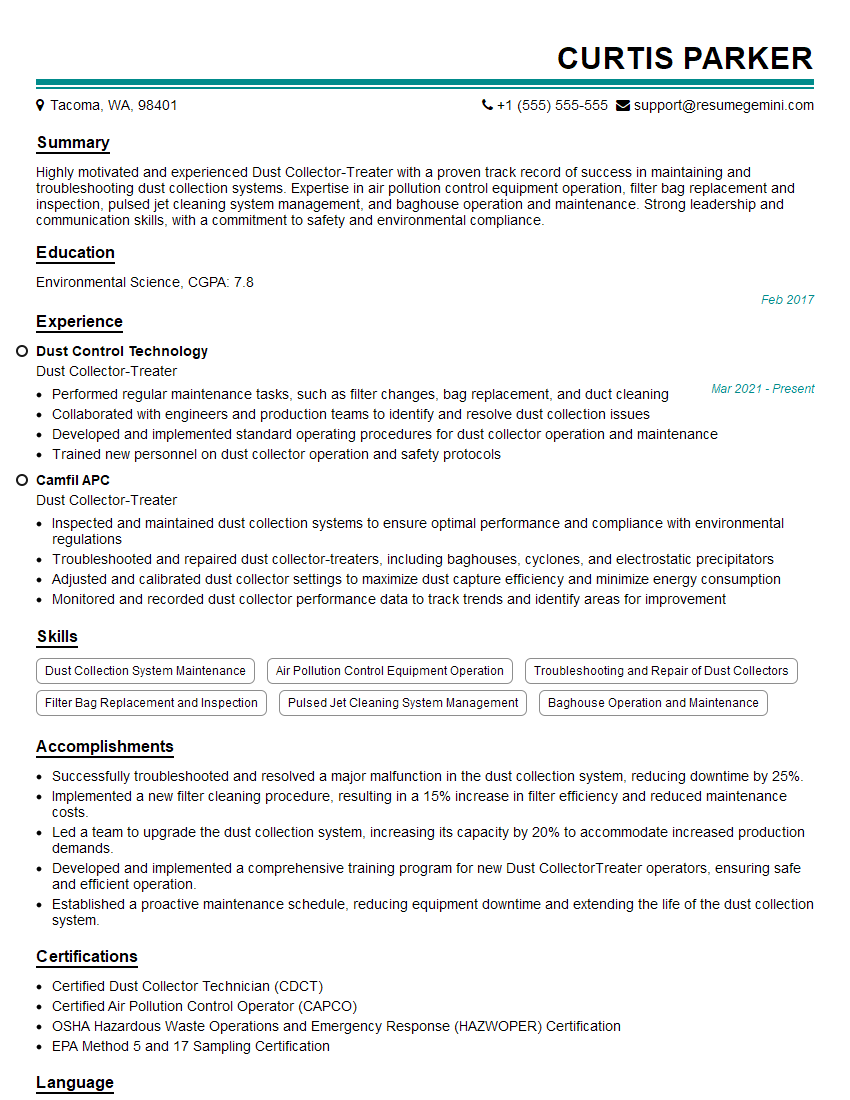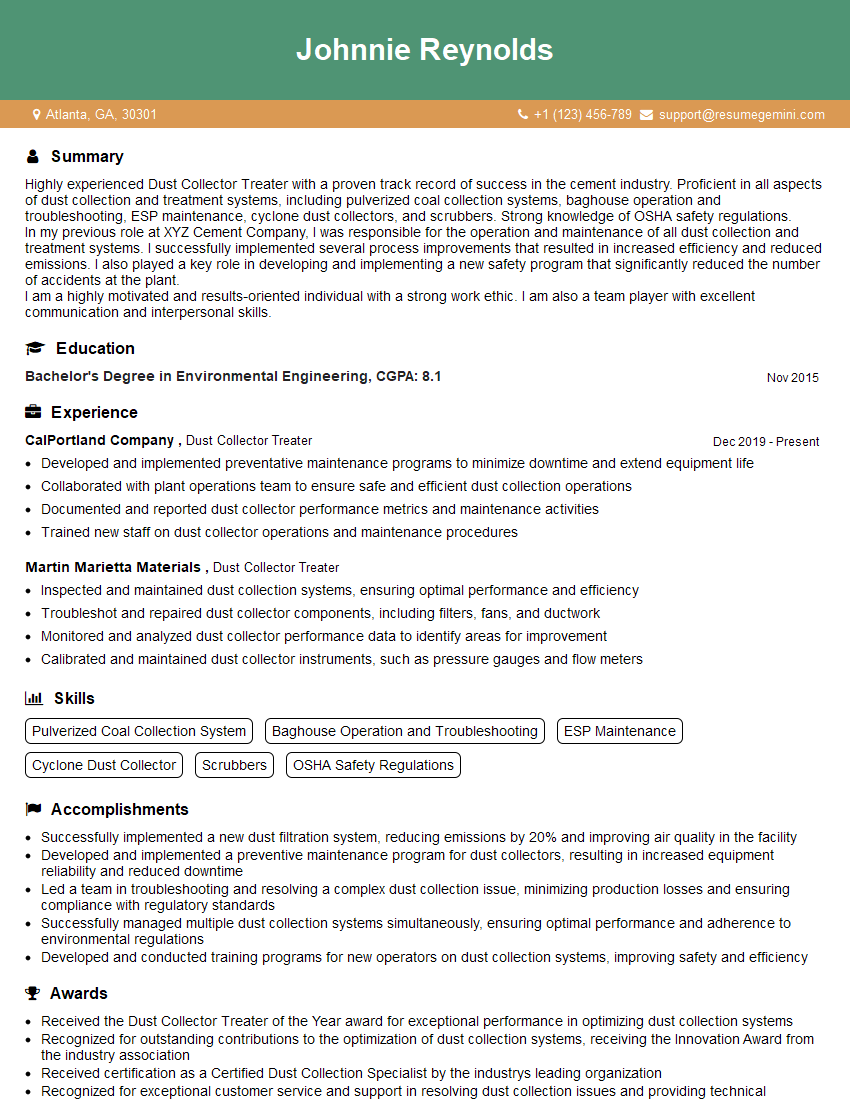Are you gearing up for a career shift or aiming to ace your next interview? Look no further! We’ve curated a comprehensive guide to help you crack the interview for the coveted Dust Collector-Treater position. From understanding the key responsibilities to mastering the most commonly asked questions, this blog has you covered. So, buckle up and let’s embark on this journey together.
Acing the interview is crucial, but landing one requires a compelling resume that gets you noticed. Crafting a professional document that highlights your skills and experience is the first step toward interview success. ResumeGemini can help you build a standout resume that gets you called in for that dream job.
Essential Interview Questions For Dust Collector-Treater
1. Explain the key components and operating principle of a baghouse dust collector?
- Filter media: Fabric or membrane that captures dust particles.
- Hopper: Collects the collected dust.
- Air inlet/outlet: Entry and exit points for the air stream.
- Dust cake: Layer of dust that forms on the filter media.
- Filter cleaning mechanism: Pulses of compressed air or shaking to remove dust cake and maintain airflow.
2. What are the different types of filter media used in baghouses, and how do their characteristics affect performance?
Woven Fabrics
- Durable, high filtration efficiency, economical
- Suitable for high-velocity applications and coarse dust
Needle Felt Fabrics
- Higher filtration efficiency, lower pressure drop
- Suitable for fine dust and higher temperature applications
Membranes
- Excellent filtration efficiency, low pressure drop
- Expensive, vulnerable to abrasion and temperature
3. Describe the importance of maintaining a proper air-to-cloth ratio in a baghouse system.
- Ensures adequate airflow to prevent plugging of filter media.
- Optimizes dust cake thickness for efficient filtration.
- Reduces the risk of premature filter failure and extends filter life.
4. What are the common methods for cleaning filter media in baghouses, and how do they compare?
Pulse Jet Cleaning
- Uses short bursts of compressed air to dislodge dust cake.
- High efficiency, suitable for a wide range of applications
Reverse Air Cleaning
- Reverses airflow to blow dust particles off the filter media.
- Suitable for heavy dust loads and sticky particles
Shaking/Vibrating Cleaning
- Mechanically shakes or vibrates the filter media to remove dust cake.
- Used for large baghouses or low dust loads
5. What are the factors that affect the efficiency of a baghouse dust collector?
- Filter media characteristics
- Air-to-cloth ratio
- Dust characteristics
- Filter cleaning mechanism
- Maintenance and operating conditions
6. Explain the purpose and function of a pulse valve in a baghouse system.
- Controls the release of compressed air for filter cleaning.
- Precision timing and correct sequencing are crucial for effective dust removal.
- Determines the pulse duration, frequency, and sequencing.
7. How would you troubleshoot and resolve a problem with insufficient airflow in a baghouse system?
- Check for plugged or obstructed filter media.
- Inspect dust buildup in the hopper and other components.
- Verify the performance of the fan and blower.
- Examine the air-to-cloth ratio and adjust if necessary.
- Clean or replace filter media if heavily loaded.
8. Describe the different types of dust collectors used to remove particulate matter from exhaust streams, and provide examples of their applications.
Baghouse Collectors
- Fabric filters for fine and coarse dust
- Applications: Industrial processes, power plants, woodworking
Electrostatic Precipitators
- Charged plates to remove particles
- Applications: Heavy industrial processes, coal-fired boilers
Cyclone Collectors
- Centrifugal force to separate particles
- Applications: Low to medium dust concentrations, woodworking
Scrubbers
- Use water or other liquids to remove particles
- Applications: Acid gases, fine particles, air pollution control
9. Explain the importance of proper maintenance and inspection for dust collector systems.
- Prevents premature failures and extends equipment lifespan.
- Ensures optimal performance and compliance with regulations.
- Identifies potential problems before they become major issues.
- Reduces downtime and operating costs.
10. How would you approach the design and selection of a dust collector system for a specific industrial application?
- Assess process requirements and dust characteristics.
- Determine appropriate airflow rate and efficiency.
- Select the most suitable dust collector type based on application.
- Estimate capital and operating costs.
- Consider future maintenance and upgrade needs.
Interviewers often ask about specific skills and experiences. With ResumeGemini‘s customizable templates, you can tailor your resume to showcase the skills most relevant to the position, making a powerful first impression. Also check out Resume Template specially tailored for Dust Collector-Treater.
Career Expert Tips:
- Ace those interviews! Prepare effectively by reviewing the Top 50 Most Common Interview Questions on ResumeGemini.
- Navigate your job search with confidence! Explore a wide range of Career Tips on ResumeGemini. Learn about common challenges and recommendations to overcome them.
- Craft the perfect resume! Master the Art of Resume Writing with ResumeGemini’s guide. Showcase your unique qualifications and achievements effectively.
- Great Savings With New Year Deals and Discounts! In 2025, boost your job search and build your dream resume with ResumeGemini’s ATS optimized templates.
Researching the company and tailoring your answers is essential. Once you have a clear understanding of the Dust Collector-Treater‘s requirements, you can use ResumeGemini to adjust your resume to perfectly match the job description.
Key Job Responsibilities
As a Dust Collector-Treater, you will be responsible for ensuring the safe and efficient operation of our dust collection and treatment systems. Key responsibilities include:
1. System Monitoring
Monitor the operation of dust collection and treatment systems, including baghouses, scrubbers, and cyclones.
- Inspect systems for proper operation, leaks, and wear.
- Monitor system parameters, such as pressure drop, airflow, and temperature.
- Identify and troubleshoot system malfunctions promptly.
2. System Maintenance
Perform regular maintenance and repairs on dust collection and treatment systems.
- Replace filters, bags, and other components as needed.
- Lubricate and adjust system components.
- Clean and inspect system components to ensure proper operation.
3. Environmental Compliance
Ensure compliance with environmental regulations related to dust emissions.
- Monitor dust emissions and maintain records as required by law.
- Work with environmental agencies to ensure compliance.
- Develop and implement dust control plans.
4. Safety
Follow all safety protocols and procedures.
- Wear appropriate personal protective equipment (PPE).
- Operate equipment safely and in accordance with manufacturer’s instructions.
- Maintain a clean and organized work area.
Interview Tips
Preparing for an interview can be daunting, but by following these tips, you can increase your chances of success:
1. Research the Company
Take the time to learn about the company you’re applying to. Visit their website, read their annual report, and check out their social media pages. This will give you a good understanding of their business, values, and culture.
- Research the company’s products or services.
- Learn about the company’s history and mission.
- Find out who the company’s competitors are.
2. Practice Your Answers
Once you’ve done your research, it’s time to start practicing your answers to common interview questions. This will help you feel more confident and prepared during the interview.
- Prepare answers to questions about your experience, skills, and qualifications.
- Practice answering questions about your strengths and weaknesses.
- Prepare questions to ask the interviewer.
3. Dress Professionally
First impressions matter, so make sure you dress professionally for your interview. This means wearing clean, pressed clothes that are appropriate for the office environment.
- Choose clothes that are comfortable and allow you to move freely.
- Avoid wearing clothes that are too revealing or too casual.
- Make sure your shoes are clean and polished.
4. Be Yourself
The most important thing is to be yourself during your interview. Don’t try to be someone you’re not, because the interviewer will be able to tell. Just relax, be confident, and let your personality shine through.
- Be honest and authentic in your answers.
- Don’t be afraid to show your enthusiasm for the position.
- Be yourself and let the interviewer get to know the real you.
Next Step:
Armed with this knowledge, you’re now well-equipped to tackle the Dust Collector-Treater interview with confidence. Remember, a well-crafted resume is your first impression. Take the time to tailor your resume to highlight your relevant skills and experiences. And don’t forget to practice your answers to common interview questions. With a little preparation, you’ll be on your way to landing your dream job. So what are you waiting for? Start building your resume and start applying! Build an amazing resume with ResumeGemini.

